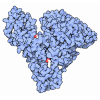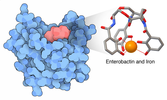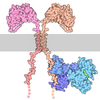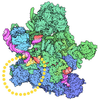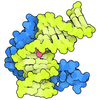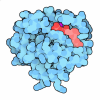[English] 日本語
 Yorodumi
Yorodumi- PDB-6d04: Cryo-EM structure of a Plasmodium vivax invasion complex essentia... -
+ Open data
Open data
- Basic information
Basic information
| Entry | Database: PDB / ID: 6d04 | |||||||||
|---|---|---|---|---|---|---|---|---|---|---|
| Title | Cryo-EM structure of a Plasmodium vivax invasion complex essential for entry into human reticulocytes; two molecules of parasite ligand, subclass 1. | |||||||||
 Components Components |
| |||||||||
 Keywords Keywords | CELL INVASION / malaria / Plasmodium vivax / reticulocyte / invasion | |||||||||
| Function / homology |  Function and homology information Function and homology informationtransferrin receptor activity / postsynaptic recycling endosome membrane / negative regulation of mitochondrial fusion / iron chaperone activity / transferrin receptor binding / positive regulation of isotype switching / Transferrin endocytosis and recycling / basal part of cell / response to manganese ion / Differentiation of Keratinocytes in Interfollicular Epidermis in Mammalian Skin ...transferrin receptor activity / postsynaptic recycling endosome membrane / negative regulation of mitochondrial fusion / iron chaperone activity / transferrin receptor binding / positive regulation of isotype switching / Transferrin endocytosis and recycling / basal part of cell / response to manganese ion / Differentiation of Keratinocytes in Interfollicular Epidermis in Mammalian Skin / response to iron ion / RND1 GTPase cycle / RND2 GTPase cycle / response to copper ion / RHOB GTPase cycle / Golgi Associated Vesicle Biogenesis / RHOC GTPase cycle / RHOJ GTPase cycle / RHOQ GTPase cycle / CDC42 GTPase cycle / RHOH GTPase cycle / RHOG GTPase cycle / endocytic vesicle / RHOA GTPase cycle / RAC2 GTPase cycle / RAC3 GTPase cycle / response to retinoic acid / regulation of postsynaptic membrane neurotransmitter receptor levels / transport across blood-brain barrier / positive regulation of B cell proliferation / clathrin-coated pit / positive regulation of T cell proliferation / Hsp70 protein binding / RAC1 GTPase cycle / response to nutrient / ferric iron binding / basal plasma membrane / osteoclast differentiation / cellular response to leukemia inhibitory factor / transferrin transport / acute-phase response / cellular response to iron ion / Post-translational protein phosphorylation / positive regulation of protein-containing complex assembly / Iron uptake and transport / clathrin-coated endocytic vesicle membrane / iron ion transport / ferrous iron binding / regulation of iron ion transport / HFE-transferrin receptor complex / recycling endosome / regulation of protein stability / positive regulation of receptor-mediated endocytosis / receptor internalization / multicellular organismal-level iron ion homeostasis / positive regulation of protein localization to nucleus / cellular response to xenobiotic stimulus / Regulation of Insulin-like Growth Factor (IGF) transport and uptake by Insulin-like Growth Factor Binding Proteins (IGFBPs) / recycling endosome membrane / antibacterial humoral response / melanosome / late endosome / positive regulation of proteasomal ubiquitin-dependent protein catabolic process / Cargo recognition for clathrin-mediated endocytosis / Platelet degranulation / extracellular vesicle / double-stranded RNA binding / Clathrin-mediated endocytosis / virus receptor activity / cytoplasmic vesicle / secretory granule lumen / blood microparticle / basolateral plasma membrane / vesicle / transmembrane transporter binding / intracellular iron ion homeostasis / early endosome / response to hypoxia / positive regulation of canonical NF-kappaB signal transduction / endosome / endosome membrane / intracellular signal transduction / apical plasma membrane / endoplasmic reticulum lumen / external side of plasma membrane / intracellular membrane-bounded organelle / positive regulation of gene expression / protein kinase binding / negative regulation of apoptotic process / protein-containing complex binding / perinuclear region of cytoplasm / glutamatergic synapse / enzyme binding / cell surface / protein homodimerization activity / extracellular space / RNA binding / extracellular exosome / extracellular region / identical protein binding Similarity search - Function | |||||||||
| Biological species |  Homo sapiens (human) Homo sapiens (human) | |||||||||
| Method | ELECTRON MICROSCOPY / single particle reconstruction / cryo EM / Resolution: 3.74 Å | |||||||||
 Authors Authors | Gruszczyk, J. / Huang, R.K. / Hong, C. / Yu, Z. / Tham, W.H. | |||||||||
 Citation Citation |  Journal: Nature / Year: 2018 Journal: Nature / Year: 2018Title: Cryo-EM structure of an essential Plasmodium vivax invasion complex. Authors: Jakub Gruszczyk / Rick K Huang / Li-Jin Chan / Sébastien Menant / Chuan Hong / James M Murphy / Yee-Foong Mok / Michael D W Griffin / Richard D Pearson / Wilson Wong / Alan F Cowman / ...Authors: Jakub Gruszczyk / Rick K Huang / Li-Jin Chan / Sébastien Menant / Chuan Hong / James M Murphy / Yee-Foong Mok / Michael D W Griffin / Richard D Pearson / Wilson Wong / Alan F Cowman / Zhiheng Yu / Wai-Hong Tham /    Abstract: Plasmodium vivax is the most widely distributed malaria parasite that infects humans. P. vivax invades reticulocytes exclusively, and successful entry depends on specific interactions between the P. ...Plasmodium vivax is the most widely distributed malaria parasite that infects humans. P. vivax invades reticulocytes exclusively, and successful entry depends on specific interactions between the P. vivax reticulocyte-binding protein 2b (PvRBP2b) and transferrin receptor 1 (TfR1). TfR1-deficient erythroid cells are refractory to invasion by P. vivax, and anti-PvRBP2b monoclonal antibodies inhibit reticulocyte binding and block P. vivax invasion in field isolates. Here we report a high-resolution cryo-electron microscopy structure of a ternary complex of PvRBP2b bound to human TfR1 and transferrin, at 3.7 Å resolution. Mutational analyses show that PvRBP2b residues involved in complex formation are conserved; this suggests that antigens could be designed that act across P. vivax strains. Functional analyses of TfR1 highlight how P. vivax hijacks TfR1, an essential housekeeping protein, by binding to sites that govern host specificity, without affecting its cellular function of transporting iron. Crystal and solution structures of PvRBP2b in complex with antibody fragments characterize the inhibitory epitopes. Our results establish a structural framework for understanding how P. vivax reticulocyte-binding protein engages its receptor and the molecular mechanism of inhibitory monoclonal antibodies, providing important information for the design of novel vaccine candidates. | |||||||||
| History |
|
- Structure visualization
Structure visualization
| Movie |
 Movie viewer Movie viewer |
|---|---|
| Structure viewer | Molecule:  Molmil Molmil Jmol/JSmol Jmol/JSmol |
- Downloads & links
Downloads & links
- Download
Download
| PDBx/mmCIF format |  6d04.cif.gz 6d04.cif.gz | 644.6 KB | Display |  PDBx/mmCIF format PDBx/mmCIF format |
|---|---|---|---|---|
| PDB format |  pdb6d04.ent.gz pdb6d04.ent.gz | 523.2 KB | Display |  PDB format PDB format |
| PDBx/mmJSON format |  6d04.json.gz 6d04.json.gz | Tree view |  PDBx/mmJSON format PDBx/mmJSON format | |
| Others |  Other downloads Other downloads |
-Validation report
| Summary document |  6d04_validation.pdf.gz 6d04_validation.pdf.gz | 1.3 MB | Display |  wwPDB validaton report wwPDB validaton report |
|---|---|---|---|---|
| Full document |  6d04_full_validation.pdf.gz 6d04_full_validation.pdf.gz | 1.3 MB | Display | |
| Data in XML |  6d04_validation.xml.gz 6d04_validation.xml.gz | 90.7 KB | Display | |
| Data in CIF |  6d04_validation.cif.gz 6d04_validation.cif.gz | 139.8 KB | Display | |
| Arichive directory |  https://data.pdbj.org/pub/pdb/validation_reports/d0/6d04 https://data.pdbj.org/pub/pdb/validation_reports/d0/6d04 ftp://data.pdbj.org/pub/pdb/validation_reports/d0/6d04 ftp://data.pdbj.org/pub/pdb/validation_reports/d0/6d04 | HTTPS FTP |
-Related structure data
| Related structure data | 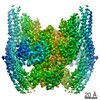 7784MC  7783C  7785C 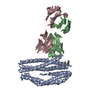 6bpaC  6bpbC 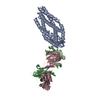 6bpcC 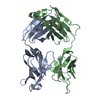 6bpdC 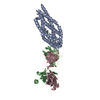 6bpeC  6d03C  6d05C M: map data used to model this data C: citing same article ( |
|---|---|
| Similar structure data |
- Links
Links
- Assembly
Assembly
| Deposited unit | 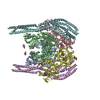
|
|---|---|
| 1 |
|
- Components
Components
-Protein , 3 types, 6 molecules ABCDEF
| #1: Protein | Mass: 73940.477 Da / Num. of mol.: 2 Source method: isolated from a genetically manipulated source Source: (gene. exp.)  Homo sapiens (human) / Gene: TFRC / Cell line (production host): Sf21 / Production host: Homo sapiens (human) / Gene: TFRC / Cell line (production host): Sf21 / Production host:  #2: Protein | Mass: 77153.906 Da / Num. of mol.: 2 / Source method: isolated from a natural source / Source: (natural)  Homo sapiens (human) / References: UniProt: P02787 Homo sapiens (human) / References: UniProt: P02787#3: Protein | Mass: 96798.477 Da / Num. of mol.: 2 Source method: isolated from a genetically manipulated source Source: (gene. exp.)  Strain: Salvador I / Gene: PVX_094255 / Production host:  |
|---|
-Sugars , 2 types, 10 molecules 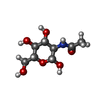
| #4: Polysaccharide | 2-acetamido-2-deoxy-beta-D-glucopyranose-(1-4)-2-acetamido-2-deoxy-beta-D-glucopyranose Source method: isolated from a genetically manipulated source #6: Sugar | ChemComp-NAG / |
|---|
-Non-polymers , 3 types, 10 molecules 

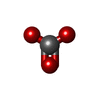


| #5: Chemical | | #7: Chemical | ChemComp-FE / #8: Chemical | ChemComp-CO3 / |
|---|
-Details
| Has protein modification | Y |
|---|
-Experimental details
-Experiment
| Experiment | Method: ELECTRON MICROSCOPY |
|---|---|
| EM experiment | Aggregation state: PARTICLE / 3D reconstruction method: single particle reconstruction |
- Sample preparation
Sample preparation
| Component | Name: ternary complex between human transferrin receptor 1, transferrin and Plasmodium vivax reticulocyte-binding protein 2b Type: COMPLEX / Details: two molecules of parasite ligand, subclass 1 / Entity ID: #1-#3 / Source: MULTIPLE SOURCES | ||||||||||||||||
|---|---|---|---|---|---|---|---|---|---|---|---|---|---|---|---|---|---|
| Source (natural) | Organism:  Homo sapiens (human) Homo sapiens (human) | ||||||||||||||||
| Source (recombinant) | Organism:  Homo sapiens (human) Homo sapiens (human) | ||||||||||||||||
| Buffer solution | pH: 7.5 | ||||||||||||||||
| Buffer component |
| ||||||||||||||||
| Specimen | Embedding applied: NO / Shadowing applied: NO / Staining applied: NO / Vitrification applied: YES | ||||||||||||||||
| Vitrification | Cryogen name: ETHANE |
- Electron microscopy imaging
Electron microscopy imaging
| Experimental equipment |  Model: Titan Krios / Image courtesy: FEI Company |
|---|---|
| Microscopy | Model: FEI TITAN KRIOS |
| Electron gun | Electron source:  FIELD EMISSION GUN / Accelerating voltage: 300 kV / Illumination mode: FLOOD BEAM FIELD EMISSION GUN / Accelerating voltage: 300 kV / Illumination mode: FLOOD BEAM |
| Electron lens | Mode: BRIGHT FIELD |
| Image recording | Average exposure time: 15 sec. / Electron dose: 80 e/Å2 / Detector mode: SUPER-RESOLUTION / Film or detector model: GATAN K2 SUMMIT (4k x 4k) / Num. of grids imaged: 1 |
| Image scans | Sampling size: 5 µm / Movie frames/image: 50 |
- Processing
Processing
| EM software |
| ||||||||||||||||
|---|---|---|---|---|---|---|---|---|---|---|---|---|---|---|---|---|---|
| CTF correction | Type: PHASE FLIPPING AND AMPLITUDE CORRECTION | ||||||||||||||||
| 3D reconstruction | Resolution: 3.74 Å / Resolution method: FSC 0.143 CUT-OFF / Num. of particles: 287253 / Symmetry type: POINT |
 Movie
Movie Controller
Controller


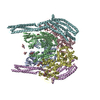




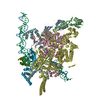


 PDBj
PDBj
